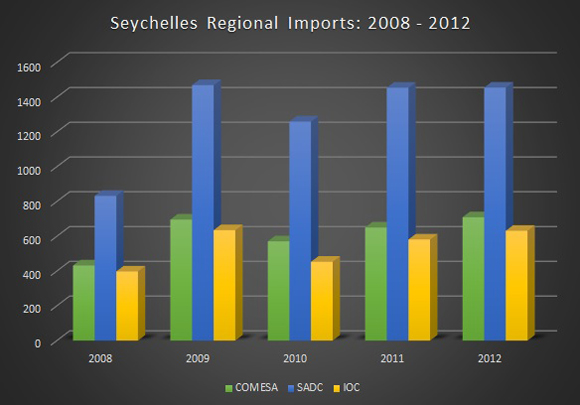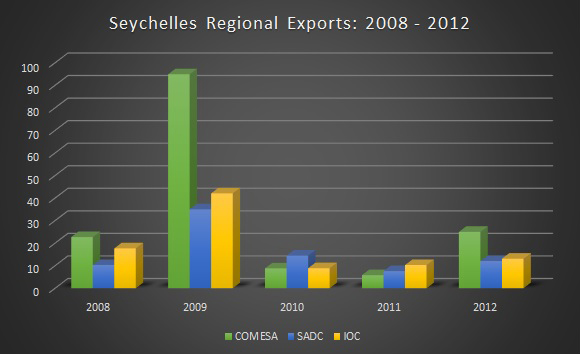A boost for struggling African regional trade: Seychelles signs up for Tripartite Free Trade Agreement
Investment |Author: Hajira Amla | June 11, 2015, Thursday @ 14:25| 211509 views
Workers offload freshly-caught tuna in Port Victoria, one of the biggest tuna transshipment ports and canning plants in the region. (Joena Bonnelame, Seychelles Nation)
(Seychelles News Agency) - Leaders from 26 African countries yesterday signed an ambitious declaration in Sharm El Sheikh, Egypt to establish a wide-reaching free-trade zone across almost the entire eastern half of the African continent.
The smallest member state of all, the 115-island archipelago of Seychelles, which lies off the eastern coastline of Africa and has a population of just 90,000 people, is upbeat about the possibilities the agreement could bring for the remote island nation.
The Tripartite Free Trade Agreement (TFTA), which incorporates member countries from the East African Community (EAC), the Common Market for Eastern and Southern Africa (COMESA) and the Southern African Development Community (SADC), will stretch from the southernmost tip of the continent to the northernmost country of Egypt.
The fast-growing region, which encompasses over 600 million people and a combined Gross Domestic Product of $1.2 trillion will be able to trade with each other more cheaply through the agreement, which will effectively remove tariffs and customs duties for domestically-produced goods traded between their borders.
Opportunities for Seychelles trade integration
Once isolated and hampered by restrictive import-export costs, the Seychelles archipelago is currently in a transition phase with regards to trade, having recently acceded to the World Trade Organisation after a negotiation process lasting around 20 years.
The island nation is a net importer of goods, with its main exports being tuna and other fresh and frozen fish and fish products. According to the Seychelles National Statistics Bureau (NBS)’s most recent publication, ‘Seychelles in Figures 2013’, in 2012, Seychelles exported some 6.8 billion Seychelles rupees ($522 million) worth of products, while its imports amounted to around 14.7 billion Seychelles rupees ($1.1 billion) – amounting to a trade deficit of around 7.9 billion Seychelles rupees ($606 million).
According to a press statement from the Seychelles Ministry of Foreign Affairs and Transport, the Seychelles Vice President, Danny Faure, who was representing President James Michel at the summit, called the creation of the free trade zone a “historic milestone” towards Africa’s regional integration.
 |
 |
| Seychelles' trade figures with regional trade bodies COMESA, SADC and the Indian Ocean Commission (IOC), displayed in millions (Seychelles rupees). Regional imports to the Indian Ocean archipelago have remained at high levels throughout the past five years while exports to neighbouring countries have been uneven. (Seychelles News Agency - source data: NBS 'Seychelles in Figures 2013') Photo License: CC-BY |
“This also shows Seychelles' continuing engagement in the African economic community's vision for a deeper economic integration," he said.
“Apart from being able to have access to a larger single regional market for both its exports and imports, Seychelles will also stand to benefit from this agreement as it is expected to streamline the import-export process for traders to the region,” reads the statement. “This in turn is expected to improve the ease of doing business and, generally, contribute to economic growth.”
The Seychelles’ biggest trading partner is France, with trade figures amounting to just under a billion Seychelles rupees ($76 million) of imports and SCR 1.6 billion ($127 million) of exports in 2012.
Although the archipelago’s regional imports to COMESA, SADC and the Indian Ocean Commission (IOC) totalled a substantial 2.8 billion Seychelles rupees ($214 million) in 2014, this was offset by weak reciprocal exports of only SCR50.2 million ($3.8 million) with Seychelles’ regional neighbours in 2012, indicating that much more can still be done to promote the exportation of Seychelles’ goods to other African countries.
On track for 2017 implementation
Signatories to the declaration must now go back to their respective national assemblies which will have to ratify the agreement and submit their instruments of accession, and a simple majority of 14 member countries will have to achieve this before the Free Trade Area will come into effect, which will probably be only in 2017.
According to an interview with South African news website Independent Online (IOL), the trade and industry commissioner at the African Union, Fatima Haram Acyl said there was no "magic wand" to get continental free trade area in place all at once.
“The European Union’s 28 countries did not wake up one day and come together as we see it today. It took them years to get where they are,” she said.
Currently, cross-border trade between African countries only amounts to around 17 percent of the continent’s total trade, and prohibitive visa rules and air links often impede African businessmen from establishing ties in other African states.
Acyl said that African migrants often drowned at sea while seeking a better life in Europe took these risks because their home countries had nothing to offer them, and added that better human resource management was necessary to entice skilled workers to stay in Africa.
For the moment, the TFTA will be limited to goods during the first phase of the negotiations, while other issues such as rules of origin, trade remedies and dispute settlement will be negotiated under the ‘built-in agenda’. The second phase of the agreement will be negotiated from July this year and will cover issues such as services, investment, intellectual property rights and competition policy.
Back
